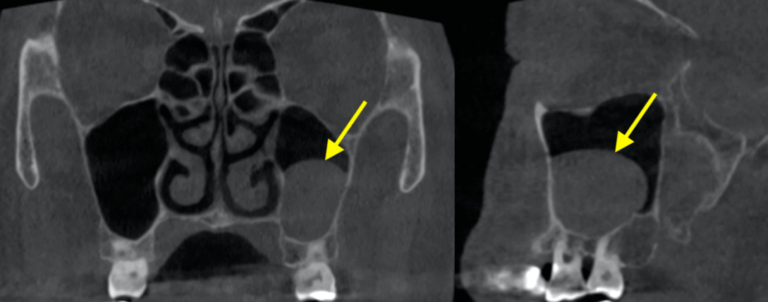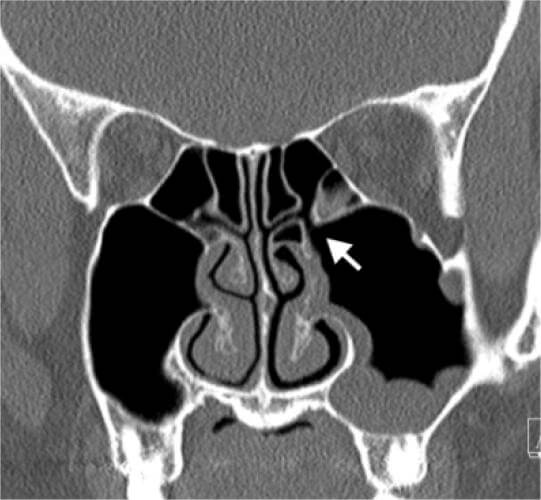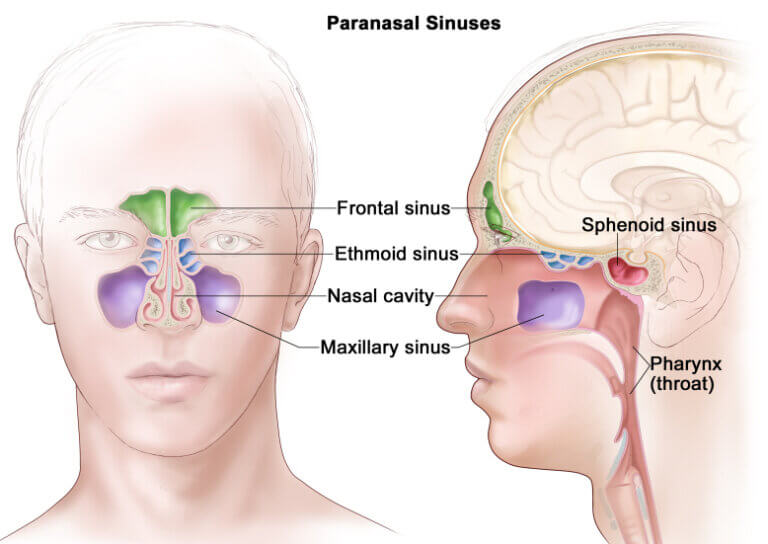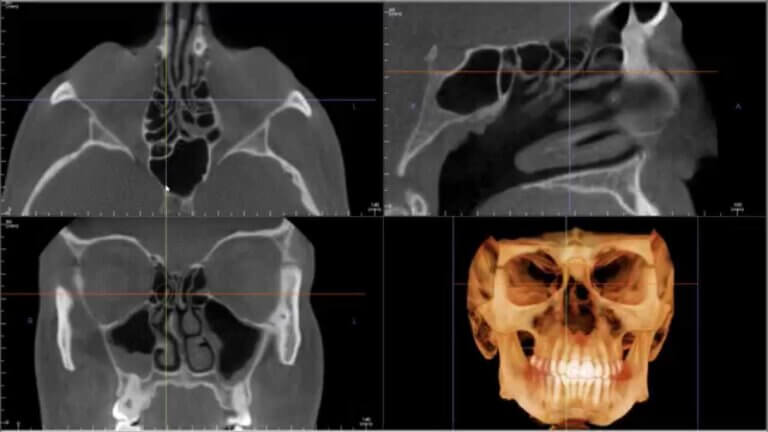CBCT Scan For Sinus Issues

Chronic sinus issues can be a persistent source of discomfort and frustration for many individuals, impacting their quality of life and overall health. In the pursuit of effective diagnosis and treatment, medical technology has evolved, offering innovative solutions such as Cone Beam Computed Tomography (CBCT) scans. These advanced imaging techniques provide detailed three-dimensional views of the sinus cavities, allowing healthcare professionals to accurately assess the underlying causes of sinus problems. Before you deciding on whether a CBCT Scan for Sinus Issues is right for you, there are some things you should know:
Table of Contents
If you have any further questions about CBCT Scans at Oral Radiology Toronto, please contact us.
What Are CBCT Scans?
Cone Beam Computed Tomography (CBCT) is a revolutionary x-ray imaging technology, providing three-dimensional views of the patient’s dental anatomy, including teeth, bones, nerves, and surrounding tissues. Unlike traditional two-dimensional X-rays, CBCT captures high-resolution, cross-sectional images by utilizing a cone-shaped beam of ionizing radiation.
The result is a detailed and accurate representation that enables dental professionals to assess anatomical structures with precision, offering a more comprehensive understanding of the patient’s oral health, including the structure and pathology of the maxillary sinuses, aiding healthcare professionals in accurate diagnosis and treatment planning for sinus-related issues.

What Is A Sinus?
The sinuses are a system of air-filled cavities located within the bones of the skull. They are lined with mucous membranes and connected to the nasal passages through small openings called ostia. The main types of sinuses include:
- Maxillary Sinuses: Located in the cheekbones on either side of the nose.
- Frontal Sinuses: Situated above the eyes in the forehead.
- Ethmoid Sinuses: Found between the eyes and the nose, on either side of the nasal cavity.
- Sphenoid Sinuses: Positioned deep within the skull behind the nose.
These interconnected cavities play several important roles, including humidifying and filtering the air we breathe, enhancing vocal resonance, and reducing the weight of the skull. However, when the sinus passages become inflamed or blocked due to infection, allergies, anatomical abnormalities, or other factors, it can lead to various sinus-related issues such as sinusitis, sinus infections, nasal congestion, facial pain, and headaches. Understanding the anatomy and function of the sinuses is crucial for diagnosing and treating sinus problems effectively, making them a key focus of medical imaging techniques like CBCT scans.

What Are Common Sinus Issues?
The maxillary sinuses, located in the cheekbones on either side of the nose, are particularly susceptible to various issues due to their proximity to the nasal passages and their size. Common maxillary sinus issues often include:
- Sinusitis: Inflammation or infection of the maxillary sinuses, which can be acute or chronic and present symptoms such as facial pain or pressure, nasal congestion, toothache, headache, and thick nasal discharge.
- Sinus Cysts: Fluid-filled sacs that can develop within the maxillary sinuses, potentially causing discomfort and affecting sinus function.
- Sinus Polyps: Noncancerous growths that can form in the lining of the maxillary sinuses, leading to congestion, difficulty breathing, and a decreased sense of smell.
- Sinus Blockage: Obstruction of the sinus ostia (openings connecting the sinuses to the nasal passages), often due to structural abnormalities like a deviated septum or nasal bone spur, resulting in recurrent sinus infections or sinus pressure.
- Sinus Fracture: Trauma to the cheekbone area can cause fractures that involve the sinus, leading to symptoms such as facial swelling, pain, and potential disruption of sinus function.
- Structural Abnormalities: Conditions like deviated septum or narrow ostia (openings connecting the sinuses to the nasal passages), which can predispose individuals to recurrent sinus infections or blockages.
Identifying and addressing these common maxillary sinus issues is essential for effective treatment and management, with CBCT scans providing detailed imaging to aid in accurate diagnosis and personalized care plans.
Why Do I Need A CBCT Scan For Sinus Issues?
CBCT scans offer numerous advantages over traditional imaging techniques when it comes to evaluating sinus issues. Here are several reasons why a CBCT scan may be necessary:
- Detailed Visualization: CBCT scans provide high-resolution, three-dimensional images of the sinuses, allowing healthcare professionals to visualize the anatomy with exceptional detail. This level of visualization is essential for identifying structural abnormalities, assessing the extent of sinus disease, and planning appropriate treatment strategies.
- Comprehensive Assessment: Unlike conventional X-rays, which offer limited views of the sinuses, CBCT scans capture images from multiple angles, providing a comprehensive assessment of the entire sinus complex. This comprehensive evaluation enables healthcare professionals to detect subtle abnormalities and accurately diagnose underlying sinus conditions.
- Precise Localization: CBCT scans allow for precise localization of pathology within the sinuses, facilitating targeted treatment approaches. Whether it’s identifying the exact location of a sinus cyst, polyp, or inflammatory changes, CBCT scans help guide interventions with greater accuracy and efficacy.
- Minimal Radiation Exposure: While CT scans provide similar detailed imaging of the sinuses, they typically involve higher radiation doses. In contrast, CBCT scans utilize cone-shaped X-ray beams that focus specifically on the area of interest, resulting in reduced radiation exposure compared to traditional CT scans.
- Enhanced Patient Comfort: CBCT scans are quick and non-invasive, making them well-tolerated by patients. With shorter scan times and minimal discomfort, CBCT imaging offers a more comfortable experience for individuals undergoing sinus evaluation.
In summary, CBCT scans are invaluable tools for assessing sinus issues due to their ability to provide detailed visualization, comprehensive assessment, precise localization, minimal radiation exposure, and enhanced patient comfort. These benefits make CBCT imaging an indispensable resource for healthcare professionals in the diagnosis and management of sinus-related conditions.

How Much Does A CBCT Scan Cost For Sinus Issues?
At Oral Radiology Toronto, we provide quick and convenient dental CBCT scans for busy dentists and patients in the downtown Toronto area. Our CBCT scans are useful for assessing the teeth, their supporting structures, the mandible and maxilla up to the floor of the nose.
Our competitively priced dental CBCT scans are professionally reviewed and interpreted by a Canadian licensed Oral Radiologist.
Prices are based on the size of CBCT volume:
- Small Field CBCT (most dental cases; 5x5cm): $227
- Medium Field CBCT : $306.45
- Large Field CBCT (8x8cm): $388.50
- Panoramic X-Ray: $82
Normal CBCT report turnaround time is up to 10 business days. Expedited reporting (2 business days) is an extra $50.
Please note that we do NOT offer field of views larger than 8x8cm or imaging of structures outside the maxilla and mandible, such as the temporomandibular joints, paranasal sinuses, the cervical spine, the neck and the airway spaces (i.e. craniofacial CT scan).
How Do I Get A CBCT Scan For Sinus Issues?
- For Referring Dentists: Refer a dental patient for a CBCT Scan using our Online Referral Form.
- For Dental Patients: Schedule a CBCT scan visit at Oral Radiology Toronto using our Online Appointment Booking System.
